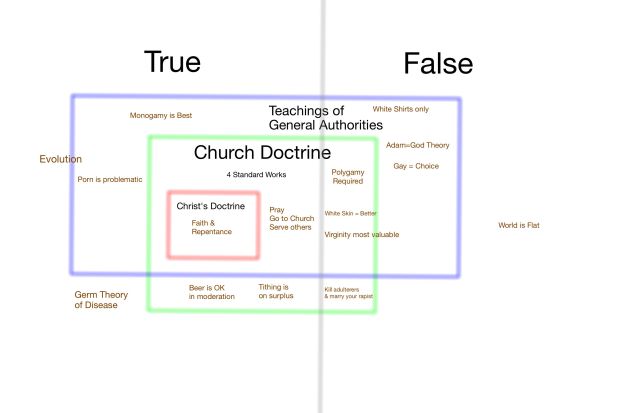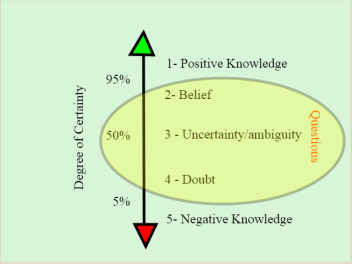Doctrine is a tricky word to define in an LDS context. There are many ways it can be defined. Some define it as anything said by a General Authority; or said in conference or published in the Ensign, or in Mormon Doctrine, or published by an LDS owned company, or available at Deseret Book, or…. etc. More recently, it’s been described as things which are consistently taught by the presiding Elders of the Church. However, the best definition I’ve come across is that the Church’s Doctrine are those teachings which are binding upon the church… that is, the 4 standard works of the church. Anything above and beyond that is to be judged based on those standard works. They have been presented to the body of the church and accepted by common consent.
The trouble really starts when people start talking about doctrine being unchanging. If you accept most of the definitions listed above, you run into trouble when you find that Church leaders once were consistently proclaiming that Adam was God our Father, or that black skin was a curse for being less valiant in the pre-existence; two “doctrines” that have now been labeled as false by the living prophets. However, you really still have issues of calling doctrine “unchanging” if you just limit yourself to the standard works… I mean, doctrine was changing rapidly at the beginning of the restoration as Joseph was adding to the cannon. If D&C 132 wasn’t a change, I don’t know what could possibly qualify.
So, how do we separate in our minds the difference between truth, doctrine, practice, teachings of the Apostles and prophets? I put together the little diagram below trying to better picture all this in my own head.

Above, we see the first broad distinction, between those things which are true vs false. From there, I think it’s simplest to start in the center, and work your way out. At the heart of it all is Christ’s Doctrine. Note this is a subset of the larger box of Church Doctrine. This is because Christ Himself defined His Doctrine:
“This is my doctrine, and it is the doctrine which the Father hath given unto me… and I bear record that the Father commandeth all men, everywhere, to repent and believe in me.
“And whoso believeth in me, and is baptized, the same shall be saved; and they are they who shall inherit the kingdom of God. And whoso believeth not in me, and is not baptized, shall be damned… Verily, verily, I say unto you, that this is my doctrine (3 Nephi 11).
Moving out from this center of the gospel, Christ’s Doctrine, we move into other important parts of the gospel, but which are “appendages” of the gospel, rather than it’s core. These “appendages” are also important, and true, and are contained within the 4 standard works; such items as the sacrament, meeting together oft, serving others, etc would fall into this category. Notably, however, these are not simply concentric rings, and there are some things which are found within the standard works, which most members would agree are not true principles: for example, that adulterers should be executed, or that appropriate punishment for raping a girl is to pay her father some money and marry her. In another box, we find items in scripture which are not true (in my opinion), yet many are actually taught by General Authorities (current or recent past), including the idea that polygamy is not only OK, but will be required of all who enter the Celestial Kingdom, or that God views white skin as the best.
Interestingly, there are also items which are found in the scriptures, that I’d argue are actually true, yet they aren’t included in the box of things taught by the General Authorities. A couple of examples are listed, including how to pay an appropriate tithing (10% of surplus), or that the Word of Wisdom actually gives the OK to beer (aka mild barley drinks).
Moving further out, we find the teachings of the General authorities. This will include lots of teachings on the Doctrine of Christ, many good teachings about the Scriptures, and many other ventures into other opinions and interpretations, both true and false.
Finally, in the outer edges, you could list endless statements which are not particularly related to the gospel, such as the mass of a proton, the mode of transmission of Zika virus. I listed Evolution largely in this category, with a small corner poking into the GA box, as you can find teachings accepting of evolution, though you’ll find many times more statements adamantly against it, which could go in a different box.
Summary
Language is tricky, and communication is hard. It is harder when we use the same word to mean different things at different times, but pretend there is only one way to use it. “Doctrine”, is typically used by members of the church to mean either the official position of the Church leaders on something, or to mean whatever is actually true. Those two are not synonymous. And defining doctrine as unchanging makes one of them impossible. I can see only two ways of seeing doctrine as unchanging.
- Doctrine = Truth… but then the word doctrine loses its utility… if you’re telling me the church position can change on something, but not on those things which are true, you’re not giving me any information I can use. How do I know which of the “teachings” are actually doctrine vs not.
- Doctrine = Christ’s Doctrine: Here, we do finally have something which doesn’t change. Faith, repentance and baptism. It’s that simple, and in its simplicity it doesn’t change.
Instead, I think the more useful definition is to see doctrine as those teachings accepted by the body of the Church as binding… mostly true, but surely containing some misconceptions and misunderstandings, which will be corrected line upon line.


 A few weeks ago in
A few weeks ago in 
 I have been working hard lately to understand what to make of doubt. To see where it fits into proper religious life. I’m not sure what’s going on, as there seems to be a lot of similar effort going around, including a fabulous post over at
I have been working hard lately to understand what to make of doubt. To see where it fits into proper religious life. I’m not sure what’s going on, as there seems to be a lot of similar effort going around, including a fabulous post over at  Now I’d like to quote John Dehlin, while explaining his views on ordinances:
Now I’d like to quote John Dehlin, while explaining his views on ordinances:
 VS
VS 
